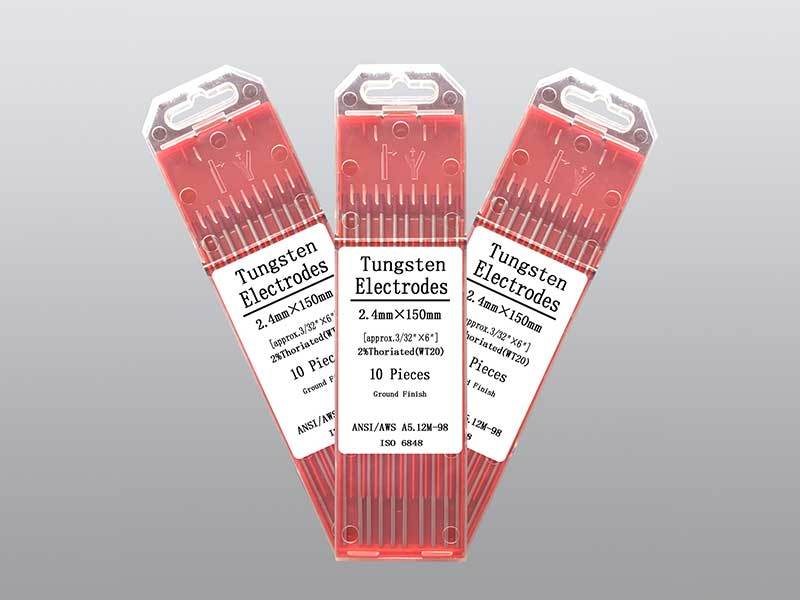news&blog
Tungsten electrode types, characteristics and its main application areas
2022-02-10
Tungsten has been widely used as a thermoelectric material in industry, and as a filament in the lighting industry. But pure tungsten as electrode material, its low emission efficiency, high fugitive power (4.52e V), current capacity is small, burned under high current is more serious

Tungsten has been widely used as a thermoelectric material in industry, and as a filament in the lighting industry. But pure tungsten as electrode material, its low emission efficiency, high fugitive power (4.52e V), current capacity is small, burned under high current is more serious, working at high temperatures for a long time will occur recrystallization phenomenon, the formation of equiaxial grain organization, so that the material becomes brittle and fracture. Pure tungsten electrode does not add any rare earth oxides, the smallest electron emission capacity, so only suited for AC large load conditions of welding, such as aluminum and aluminum-magnesium alloy welding.
Thoriated tungsten electrode material invention began in 1913, is in the pure tungsten doped with about 2% of thorium dioxide (T h O2). Thoriated tungsten electrodes have the advantages of easy arc initiation, arc stability, high current carrying capacity, resistance to weld contamination, etc., and their fugitive power is half of that of pure tungsten, i.e., 2.62e V. Thoriated tungsten electrodes are traditional electrodes with excellent welding performance, and they are usually used in the direct current welding of carbon steel, stainless steel, nickel alloy, and titanium metal. However, thorium is a naturally occurring radioactive element, and its processing and use, as well as the recycling and reuse of scrap materials, can easily cause radioactive contamination of the human body and the environment, thus posing a hazard to the environment and human beings.
At present, the annual consumption of tungsten electrode materials used for TIG welding at home and abroad has reached thousands of tons, and improper handling may cause serious environmental pollution. Due to governmental restrictions, relevant manufacturers in the U.S. and the European Union have stopped production of thoriated tungsten materials or transferred production to developing countries. With the increasing concern for environmental protection and occupational health, it is an inevitable trend to stop the production and use of thoriated tungsten globally. In the past 20 years, with the continuous development of technology, welding technology and cutting materials have become more diversified in terms of varieties, specifications and shapes, and a series of new technologies and processes, such as automated welding, plasma spraying, plasma cutting and high-precision welding, are emerging in the fields of modern TIG (tungsten inert gas shielding) and PLASMA (plasma), which place higher demands on the reliability and stability of the electrode materials. At the same time, in order to keep pace with the human civilization, the electrode material has to be more reliable and stable. At the same time, in order to adapt to the development of human society and civilization, the environmental impact of tungsten electrode materials in the production and use of the process also has higher and more demanding requirements. For this reason, materials researchers from all over the world are working on the development of various new tungsten electrode materials.
So far, the progress in replacing radioactive thorium tungsten electrodes has basically focused on rare-earth (cerium, lanthanum, yttrium and their composite rare-earth oxides) tungsten electrode materials. At present, in the electrode products that do not contain radioactive element thorium, the electrode that is used more is cerium tungsten electrode. Since the 1970s and 1980s, China's Shanghai Light Bulb Factory, Beijing Tungsten and Molybdenum Materials Factory and so on have invested in the development and production of cerium tungsten materials, cerium tungsten electrodes have been included in the International Organization for Standardization international standards for non-melting electrodes. Cerium tungsten electrode has the advantages of good arc starting effect, burnout resistance, long life and so on. Since cerium tungsten electrode is developed to replace the radioactive thorium tungsten material, it has a wide application market both at home and abroad, especially in the tungsten electrode for small-size welding, it has successfully replaced thorium tungsten electrode, and won wide praise from users. However, cerium tungsten electrode cannot completely replace thorium tungsten electrode in AC hydrogen arc welding electrode and cathode material of high-power ultra-high-voltage spherical atmosphere lamp, etc., and there is still a situation of unstable welding current. Meanwhile, cerium tungsten electrodes also have the shortcomings of poorer arc-inducing performance and shorter service life.



